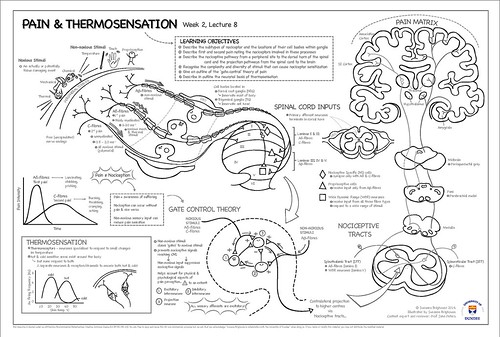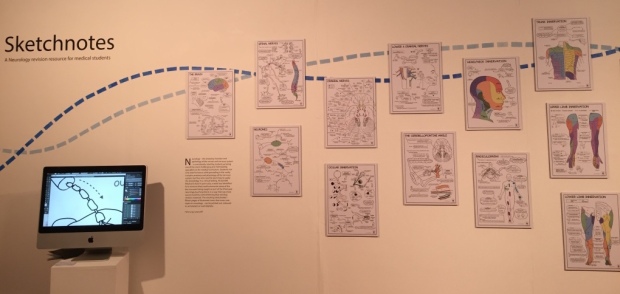Over the past few years at Dundee we’ve had growing opportunities to work with our colleagues in medical art and suggest project ideas to students studying the Masters programme. There have been some great projects over the years with students developing learning resources, creating comics to support patient communication and exploring the potential of 3D printing to help surgeons. With a long standing interest in the potential of sketchnotes to support student leanrning and in particular revision I’ve pitched a project idea around sketch notes for a couple of years but it’s never grabbed anyone’s attention. This year I floated the idea again and suggested a focus on neurology teaching given that many medical students seem to find this a challenging area of medicine and I was delighted when Susanna Brighouse took on the challenge. First off Susanna created a sketchnote based on a lecture on pain and thermosensation and is with all our student developed resources it was peer reviewed by one of our academics. She produced different versions including one that could be coloured in and labelled by students to support revision.
Following positive feedback Susanna went on to make sketchnotes the focus of her Masters project and produced a further 15 sketchnotes based on a series of neurology lectures covering topics such as the anatomy of the spinal nerves, body innervation maps and radiculopathy. Feedback on the sketchnotes from medical students identified that they would make most use of them to help revision. We hope to share these further sketchnotes soon.
Alongside with Susanna’s project there were a few others with a medical education focus where the students had worked closely with Dr Richard Oparka our pathology teaching lead. Two of the projects were super animations, first up a delightful video on the phases and main components of the cell cycle by Cristina Sala Ripoll, which Richard will be using in his teaching with 1st year medical students in a few weeks time. The video highlights the the different phases of the cell cycle that lead to cell division and includes some of the cellular components involved in them.
The second animation comes from Elvire Thouvenot-Nitzan and gives an overview of apoptosis looking at the important role apoptosis plays in growth and development as well as removing DNA damaged cells. It goes on to show how the activation of the caspase cascade occurs in each external and internal signalling pathway and ends with a glimpse of cancer cells and their ability to block apoptosis.
The fourth project I want to showcase is Anna Sieben’s 3D epithelium. Anna, who’s a doctor, has created a fantastic teaching resource for medical students on epithelium which links to the virtual microscope used in teaching at Dundee. Students can select to look at the epithelium in different body organs and explore the structure and function of these different tissues through a series of 3D models. I’ve embedded Anna’s model of the epithelium of the skin from sketchfab below. You can 3D print these models from sketchfab and Anna had a wonderful display of these at her degree show.
There’s a lot of focus on technology enhanced learning in medical education and higher education at the moment but I get the impression it’s rare to find medical artists in elearning teams. At Dundee we’re very lucky to have two medical artists in Annie Campbell in medicine and Emily McDougall in dentistry but we don’t have similar posts at the moment in the central elearning team or in other schools. Much of the work that Annie and Emily produce is shared as OER and FAOMed so that others can reuse these resources to support medical and dental education.
Susanna, Cristina, Elvire and Anna are four super talented medical artists and I hope they get snapped up with job offers from other medical or dental schools. I’m looking forward to following their work in the future.


One comment